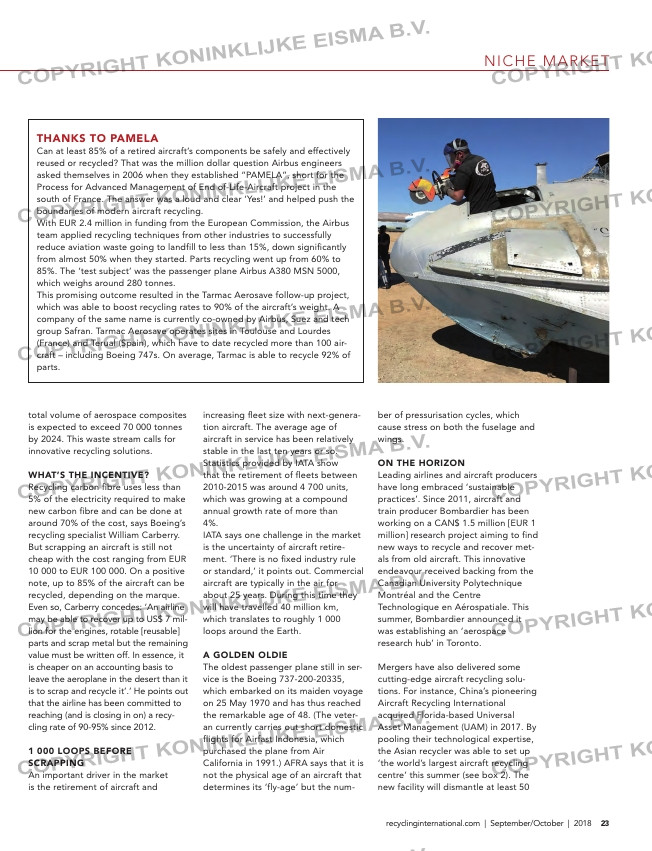Page 23 from: Autumn issue 2018

Niche Market
total volume of aerospace composites
is expected to exceed 70 000 tonnes
by 2024. This waste stream calls for
innovative recycling solutions.
what’s the incentive?
Recycling carbon fibre uses less than
5% of the electricity required to make
new carbon fibre and can be done at
around 70% of the cost, says Boeing’s
recycling specialist William Carberry.
But scrapping an aircraft is still not
cheap with the cost ranging from EUR
10 000 to EUR 100 000. On a positive
note, up to 85% of the aircraft can be
recycled, depending on the marque.
Even so, Carberry concedes: ‘An airline
may be able to recover up to US$ 7 mil-
lion for the engines, rotable [reusable]
parts and scrap metal but the remaining
value must be written off. In essence, it
is cheaper on an accounting basis to
leave the aeroplane in the desert than it
is to scrap and recycle it’.’ He points out
that the airline has been committed to
reaching (and is closing in on) a recy-
cling rate of 90-95% since 2012.
1 000 looPs Before
scraPPing
An important driver in the market
is the retirement of aircraft and
increasing fleet size with next-genera-
tion aircraft. The average age of
aircraft in service has been relatively
stable in the last ten years or so.
Statistics provided by IATA show
that the retirement of fleets between
2010-2015 was around 4 700 units,
which was growing at a compound
annual growth rate of more than
4%.
IATA says one challenge in the market
is the uncertainty of aircraft retire-
ment. ‘There is no fixed industry rule
or standard,’ it points out. Commercial
aircraft are typically in the air for
about 25 years. During this time they
will have travelled 40 million km,
which translates to roughly 1 000
loops around the Earth.
a golDen olDie
The oldest passenger plane still in ser-
vice is the Boeing 737-200-20335,
which embarked on its maiden voyage
on 25 May 1970 and has thus reached
the remarkable age of 48. (The veter-
an currently carries out short domestic
flights for Airfast Indonesia, which
purchased the plane from Air
California in 1991.) AFRA says that it is
not the physical age of an aircraft that
determines its ‘fly-age’ but the num-
ber of pressurisation cycles, which
cause stress on both the fuselage and
wings.
on the horiZon
Leading airlines and aircraft producers
have long embraced ‘sustainable
practices’. Since 2011, aircraft and
train producer Bombardier has been
working on a CAN$ 1.5 million [EUR 1
million] research project aiming to find
new ways to recycle and recover met-
als from old aircraft. This innovative
endeavour received backing from the
Canadian University Polytechnique
Montréal and the Centre
Technologique en Aérospatiale. This
summer, Bombardier announced it
was establishing an ‘aerospace
research hub’ in Toronto.
Mergers have also delivered some
cutting-edge aircraft recycling solu-
tions. For instance, China’s pioneering
Aircraft Recycling International
acquired Florida-based Universal
Asset Management (UAM) in 2017. By
pooling their technological expertise,
the Asian recycler was able to set up
‘the world’s largest aircraft recycling
centre’ this summer (see box 2). The
new facility will dismantle at least 50
23recyclinginternational.com | September/October | 2018
thanks to Pamela
Can at least 85% of a retired aircraft’s components be safely and effectively
reused or recycled? That was the million dollar question Airbus engineers
asked themselves in 2006 when they established “PAMELA”, short for the
Process for Advanced Management of End of-Life-Aircraft project in the
south of France. The answer was a loud and clear ‘Yes!’ and helped push the
boundaries of modern aircraft recycling.
With EUR 2.4 million in funding from the European Commission, the Airbus
team applied recycling techniques from other industries to successfully
reduce aviation waste going to landfill to less than 15%, down significantly
from almost 50% when they started. Parts recycling went up from 60% to
85%. The ‘test subject’ was the passenger plane Airbus A380 MSN 5000,
which weighs around 280 tonnes.
This promising outcome resulted in the Tarmac Aerosave follow-up project,
which was able to boost recycling rates to 90% of the aircraft’s weight. A
company of the same name is currently co-owned by Airbus, Suez and tech
group Safran. Tarmac Aerosave operates sites in Toulouse and Lourdes
(France) and Terual (Spain), which have to date recycled more than 100 air-
craft – including Boeing 747s. On average, Tarmac is able to recycle 92% of
parts.
22-23-24-25_aircraftrecycling-latest.indd 23 20-09-18 14:18



